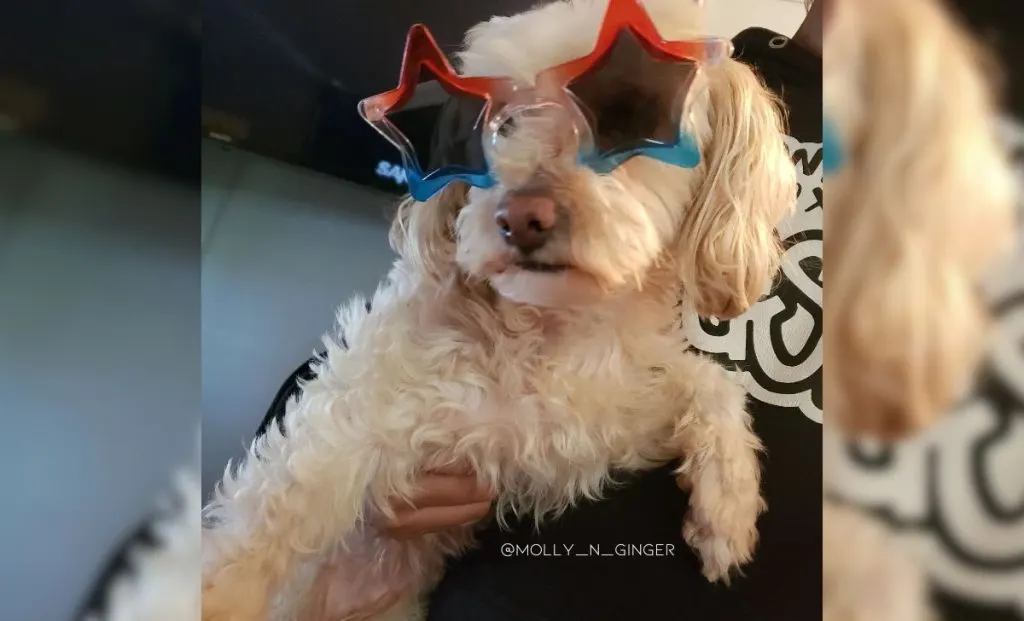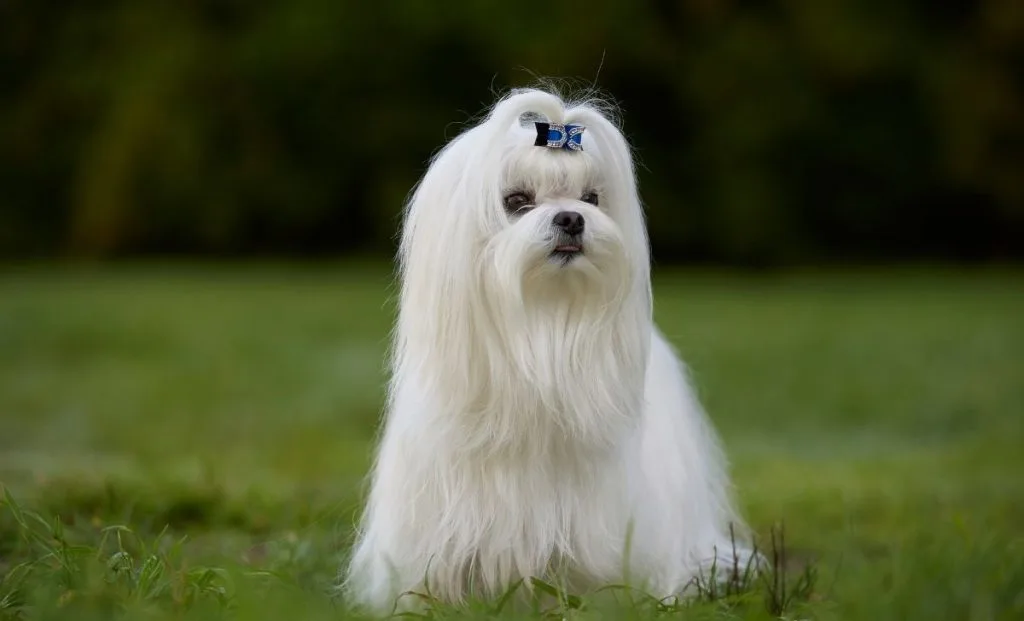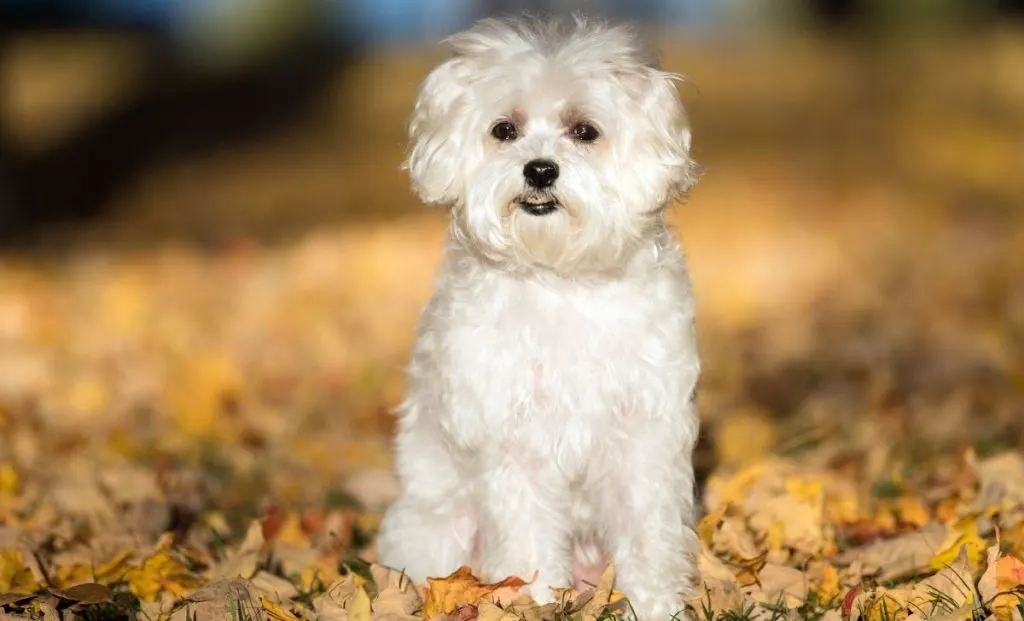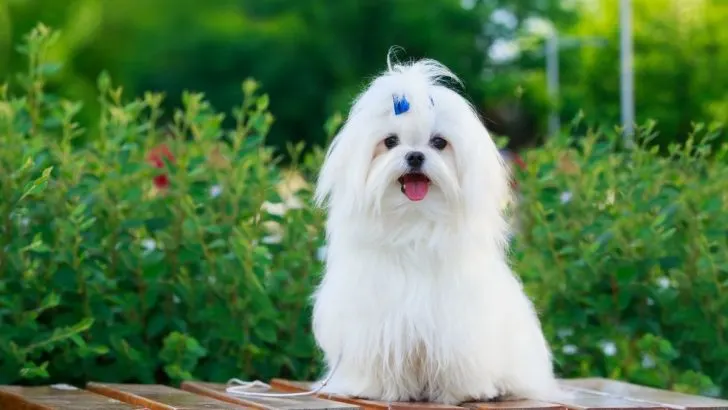White silky coats, black button eyes, and black noses – yes, it’s Maltese I’m talking about! But did you know there are more Maltese colors than most people are aware of?
Maltese is one of the most popular small dog breeds out there. There are so many famous Maltese owners! From Halle Berry, Mia Farrow, and Frank Sinatra to Josephine Bonaparte, Queen Victoria, and Marie Antoinette – everyone loves Maltese!
One of the traits Maltese are most known for is a white coat. However, this isn’t the only Maltese color that exists. Yes, you’ve read that correctly – not all Maltese are solid white. However, this doesn’t mean they are a colorful breed.
Without further ado, here are all the possible coat colors of a Maltese dog:
Possible Maltese Coat Colors
As mentioned, one common misconception of Maltese dogs is that these pups only come in white coat color.
While it’s true that the predominant color in this breed is white, all kennel clubs allow a few slightly darker shades.
Still, it’s important to keep in mind that different clubs might accept different colors. For example, what is considered a standard in the US might not be standard in Europe.
This might further increase the number of Maltese colors you might run into.
Below are six shades these pups come in, as well as one color that is forbidden.
White

According to the American Kennel Club (AKC), white is the only color that is considered a part of the Maltese breed standard. This also explains the prevalence of white Maltese dogs, as reputable breeders will strive to produce dogs suitable for show rings.
Not only that, but the white color gives these pups a striking beauty a few other breeds have.
White Maltese, as their name suggests, have to be of a solid white color. The only darker shades that are allowed are black noses, paw pads, eye rims, and lips, as well as dark brown eyes.
White And Lemon

Many white Maltese are born with lemon markings, most notably on their ears but sometimes on their backs, as well. These markings typically go away during the first few weeks of a dog’s life.
However, some Maltese never lose their lemon spots, and they are thus considered white and lemon Maltese.
While white and lemon is an accepted Maltese color, lemon markings are considered a fault, so many breeders avoid reproducing them.
On the other hand, most dog lovers adore this unique coat color, especially as lemon is a color only a few breeds have – although it is a fairly common Beagle shade, for example.
White And Tan

This is one of the alternate coat colors not many people know about, especially as tan is considered too dark for a fluffy white dog as a Maltese.
Just as is the case with lemon spots, some Maltese are born with tan markings that go away with age – although the tan color is much rarer than lemon.
Keep in mind that the tan shade present in Maltese is lighter than in most other dog breeds. Still, it is darker and deeper in hue than lemon and not as rich as orange.
White With Black Marking

While the name of this color might make you think you’re about to see a parti colored Maltese, this isn’t the case. The black marking is usually quite minimal – sometimes nothing more than black hair tips on a few areas of a dog’s face or back.
These unique markings vary from pup to pup, and it’s rare to find two Maltese with the same black spots.
Unfortunately, this combination also isn’t considered a part of the Maltese breed standard, making these pups quite rare.
Ivory

Ivory is not a recognized color in the AKC, but the Federation Cynologique Internationale (FCI) accepts it.
Also known as cream Maltese, ivory Maltese is the only recognized Maltese that doesn’t have that classic white look. Instead, it can come in a few shades of cream, but it’s usually just a bit darker than white.
While some might consider this slight shade difference to be a nitpick, if you’d put ivory Maltese next to the white one, the difference would be quite obvious.
White With Orange Marking

This is yet another alternate coat color that’s only accepted by the FCI. It is a unique shade that greatly changes this dog breed’s overall appearance.
These pups have a white base coat with light orange markings on the ears. These markings are deeper than lemon but brighter than tan.
This is also one of the rarest Maltese colors out there. Not many owners can brag about having a pup with light orange ears!
Just beware – there are a lot of unreal pictures out there. No Maltese can have markings that are literally a color of orange. Most of the time, these pictures show dogs with artificially dyed ears.
Are Black Maltese Real?
Pictures of black Maltese used to be quite popular online for a certain period of time. Many people would like to have a pet that stands out, and having a black Maltese dog would certainly fulfill just that.
Considering how there are Maltese that come in lemon and light orange shades, the thought of a black-coated Maltese doesn’t sound that wild. Or does it?
I hate to be the bearer of bad news, but there is no such thing as a black purebred Maltese pup. Black is simply not one of the natural coat colors of Maltese dogs.
Throughout history, however, there have been instances where breeders would try to create a black Maltese. They would achieve this by mixing a purebred Maltese with a black Pomeranian. However, they have created an entirely new breed instead.
A part of responsible ownership is buying a healthy dog that will be a true representative of the breed. This will help support ethical breeding practices.
By buying a puppy that is being advertised as a black Maltese dog, you will most likely support a dishonest person who is only looking for profit. So, be wary of rare colors that seem too good to be true. Chances are you’ll end up with a mutt.
Discolorations

As I’ve mentioned, many Maltese will lose their yellow, tan, or orange spots as they transition from puppyhood to adulthood. However, it is not common for adult dogs to experience any color changes, at least not due to genetics.
Still, as is the case with most predominantly white breeds, Maltese are prone to discolorations for numerous other reasons.
Here’s what I mean:
Coat Color Discolorations
Many dog owners might notice their Maltese’s coat turn yellow, especially on his paws, stomach, and muzzle. Sometimes, their entire coats will turn from white to cream!
The good news is this is most likely not due to some genetic or health problems but rather a product of regular doggy life.
In other words, the discoloration is the product of months or maybe years of staining due to dirt, debris, and other environmental factors.
As this isn’t something that happens overnight, chances are that the owners haven’t even noticed it happening until they look at some old photos and see how white their pups have been.
Nose Color Discolorations
While the accepted nose color for Maltese is black, some Maltese have two-colored noses. Owners won’t always notice this at first, making them believe their dog’s nose color has changed.
Some dogs might truly experience the fading of their nose shade, and this is typically due to environmental factors and not genetics.
Discolorations Around The Eye
One of the most common – and most disliked – discolorations happens around a white dog’s eyes, and those are the so-called tear stains.
These tear stains are the product of moisture around the eyes, which causes gradual discoloration.
Don’t worry; the red color isn’t due to blood but to red yeast or Ptyrosporin, a harmless but annoying fungi that leaves rust stains.
How To Fix And Prevent Coat Color Changes

Another part of responsible ownership is dealing not just with the delightful temperament of these pups but also with all the somewhat annoying things, and, in the case of Maltese, this includes dealing with discoloration.
While changes in color are mostly just an aesthetical problem, some are caused by a lack of hygiene. This is one of the main reasons why you’d want to do all you can to ensure your Maltese keeps his luscious, white coat.
Here are a few tips on doing just that:
Avoid Plastic Bowls
Plastic is not only harmful to the environment, but it’s also a health hazard for your pets.
Constant contact with plastic bowls, even BPA-free ones, can cause your dog’s nose color to fade over time. Switch to metal or glass ones instead.
Avoid Tap Water
One of the most common mistakes pet owners make is to give their pets water directly from the tap.
Tap water is usually non-filtered and rich in various minerals, including chlorine. These minerals can cause the coat color of a Maltese dog to change, mostly on his muzzle and chin, as this is where the most contact with water will be.
Instead, provide him with filtered water, or even try to get the information on what type of bottled water is the safest for your pet. Keep in mind that just because a certain brand of bottled water is good for you, it doesn’t have to be good for your dog or his coat.
Keep Your Maltese Warm
Maltese are sensitive pups that don’t do well in cold. Chilly winter winds can cause his nose to dry out, and the upper layer of skin will peel, leaving the lighter bottom layer exposed.
A good solution is to avoid taking your pet on long walks when the temperatures are too low. Using a dog-friendly skin balm can also help keep his skin moisturized.
Avoid Too Much Sun
Similarly, too much sun is also not good for your Maltese. This can make your dog’s nose brown, or even pink over time!
There is more than one reason why you shouldn’t take your dog on long walks in the Sun, especially in the hot summer months. Discoloration is just one of them.
Use Wipes
The best way to prevent tear stains is to use wipes to clean the area around your Maltese’s eyes at least once a week, if not more often.
This will help remove moisture and any yeast that might’ve gathered there.
Wipes are also a good solution for cleaning red stains that have already appeared. Just soak them in a bit of hydrogen peroxide beforehand, and be mindful of the dog’s eyes.
You can use wipes to clean your dog’s entire body, as well. This is a good alternative to bathing.
High-quality Shampoo
Finally, when needed, wash your Maltese with a high-quality whitening dog shampoo. Don’t go overboard – bathing your pup too often can cause more harm than good.
Pay particular attention to paws, muzzles, and other areas more prone to discoloration.
This will help remove any food leftovers, urine, and dirt from the dog’s coat.
The History Of Maltese Colors

The breed origin can be very important for understanding why a certain breed comes in coat color kennel clubs accept.
While it might not seem so, Maltese is one of the oldest dog breeds. They originated 8000 years ago – although it took quite some time before they looked as they do today.
White was always the predominant shade for this breed, but their coats didn’t have to be solid colored.
The first mention of a pure white Maltese was in 1877 when a white Maltese pup was brought to Westminster. At the time, the breed was known as the Maltese Lion Dog.
In 1879, a white Maltese with black ears appeared. This time, they called it the Maltese Skye Terrier.
Still, it took quite some time before the white color became the dominant one.
Between 1902 and 1913, the Kennel Club (KC) allowed all Maltese colors in the ring. Not only did the coats of these Maltese come in colors other than white, but they were said to have coarser hair that wasn’t as silky.
Western Influences
As the breed reached the US in the early 20th century, it was heavily crossbred, trying to perfect the look. I’ve already mentioned crossbreeding original Maltese with Pomeranians, resulting in fluffy, black pups.
However, one crossbreed gained special attention, and that was the Maltese and white toy Poodle mix. Not only did adding Poodle genes help create curlier and more hypoallergenic coats, but it also resulted in solid white puppies.
It is believed today’s Maltese dogs originate from these Poodle crossbreeds.
Still, it took quite some time before the breed became widespread. While they were accepted by the AKC in 1888, in 1902, there were only 6 Maltese dogs registered. In 1950, this number slightly increased, and there were 50 purebred Maltese dogs in the US.
However, once Maltese became known for their silky, white coats, the breed quickly gained popularity.
Genetics Of Maltese Coat Colors

Just like in all other dog breeds, the Maltese color is determined by genetics. A pup will inherit specific genes that cause a certain coat color from his parents. Then, the combination of those genes will determine what color will express itself on the dog’s body.
Unfortunately, those genes are not yet fully understood as they are rather complex, and there are numerous possible combinations.
One thing that is certain, though, is that the gene that causes white coats in Maltese is recessive. In other words, a Maltese puppy needs to inherit the gene from both of his parents to have a white coat.
This is why reputable breeders care so much about picking high-quality parent dogs for their breeding programs. All it takes is one dog with improper genes for the entire litter to lose their signature appearance.
Do Coat Colors Matter?
On the most superficial level, the answer to this is pretty obvious: No, coat colors don’t matter, as they don’t determine whether a canine is a good pet or not. They don’t affect behavior in any way, and only have an impact on a dog’s appearance.
However, the presence of colors that aren’t a part of the breed standard is typically an indication that a dog is a crossbreed. This is common with backyard breeders, who sometimes aren’t even entirely sure who the father dog is.
In other words, if you were to purchase some rare Maltese color, chances are you are paying for a mutt with an unknown background and origin.
To make things clear: There is nothing wrong with crossbreeds. However, if you pay for a purebred dog, you have certain expectations, not only about the dog’s appearance but also about his behavior and health.
If your puppy has been crossbred without you realizing it, this means you might be getting a dog with some behavioral flaws or traits you aren’t prepared for.
Not to mention you might end up with a dog with bad genetics, crippled with severe health conditions and a shortened life expectancy. No one should want to support such bad breeding practices!
So, in that sense, yes, the color of a dog’s coat can imply a lot of things. Some of them should impact your decision to buy.
Of course, if you decide to buy a dog that comes in a non-standard color, that’s entirely within your rights. Just be wary of all the dangers this might bring.

Vanja’s passion for writing started at an early age, which is why she pursued Journalism as her college degree. She can research any topic and find all the information before you bat an eye, which is a great thing for her job but a terrible one for her husband.
Even as a young child, she fell in love with everything fluffy – but dogs have a special place in her heart due to her childhood companion, a Corgie named Archie.
Motivated by her experiences and driven by a desire to give back to her four-legged companions, she spends her free time volunteering at a local dog shelter.
